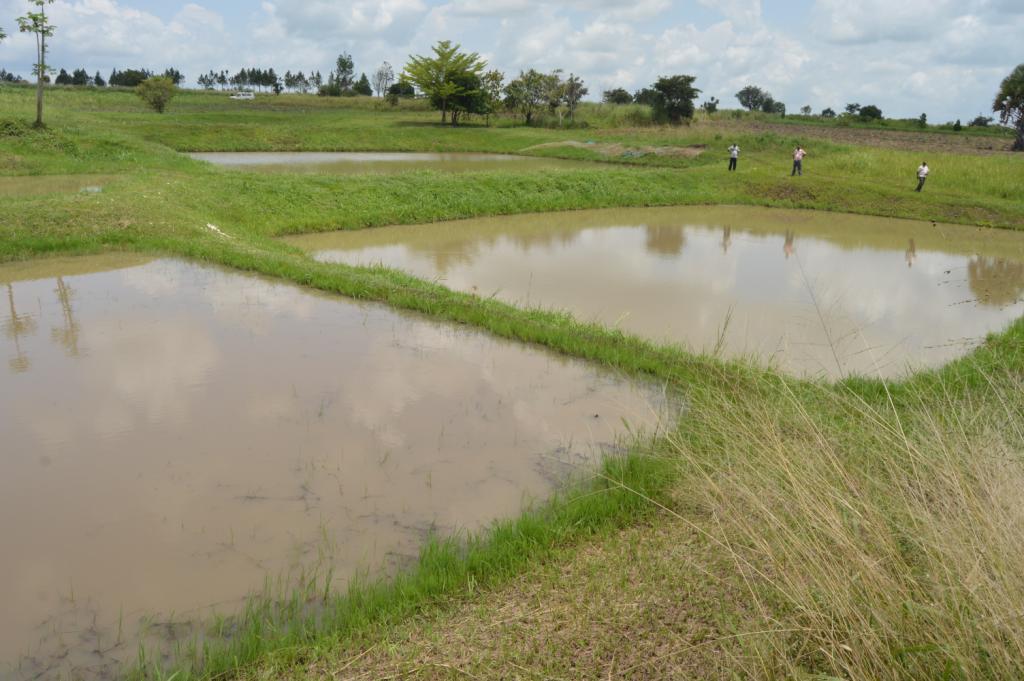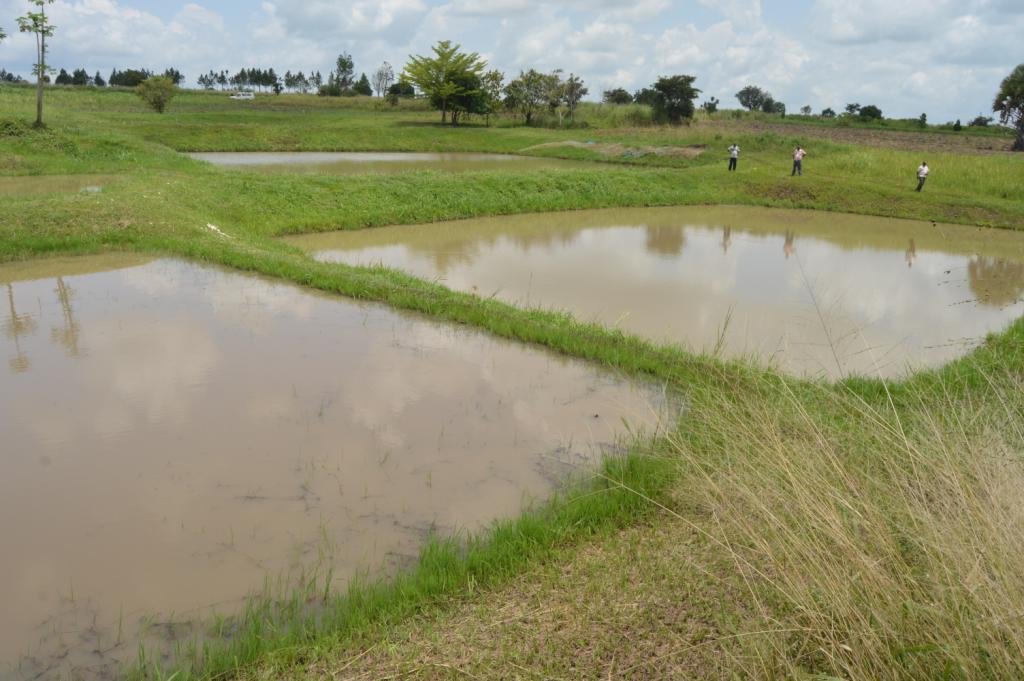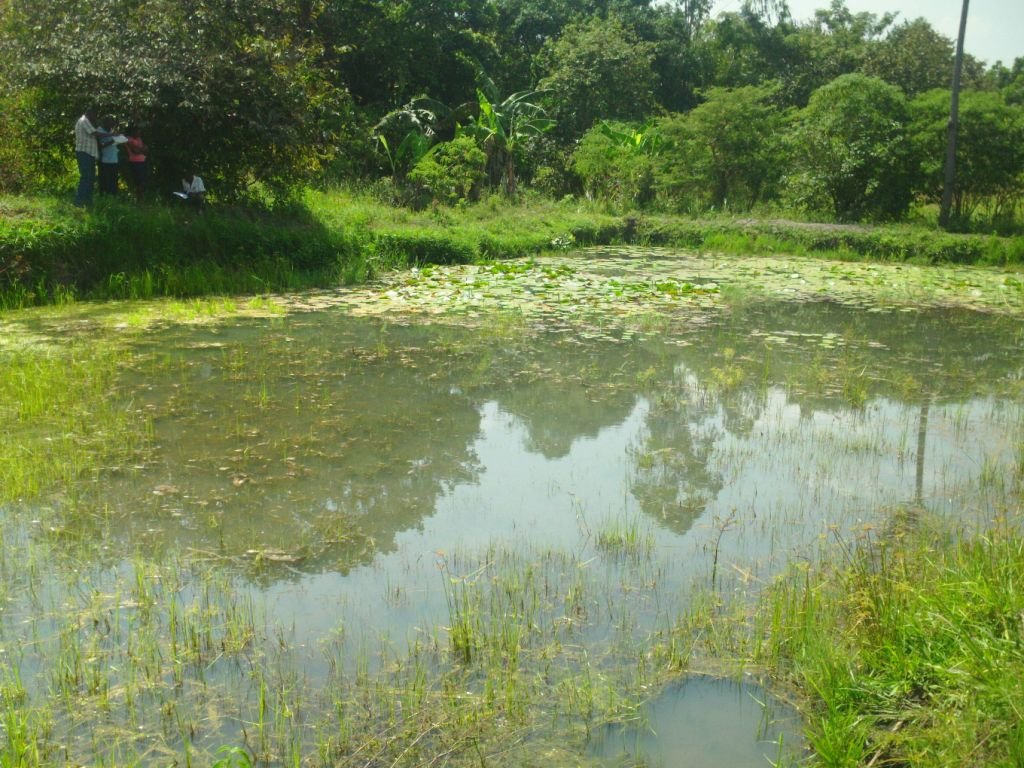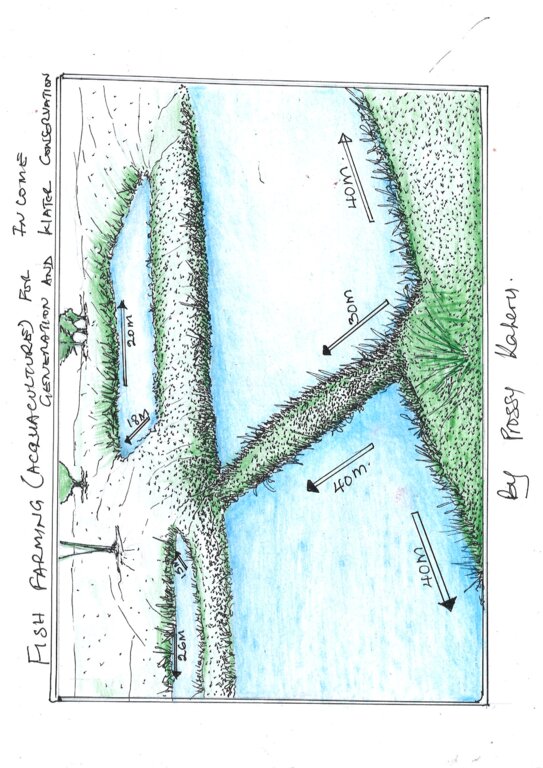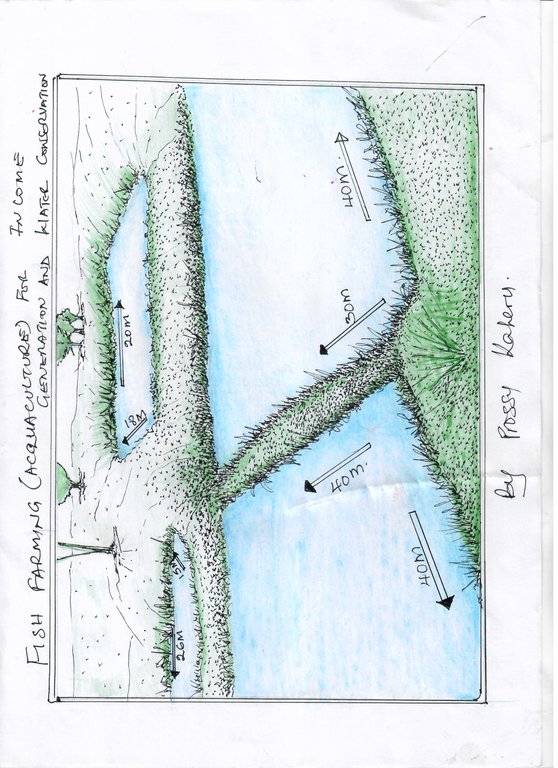FISH FARMING (AQUACULTURE) FOR INCOME GENERATION AND WATER CONSERVATION [乌干达]
- 创建:
- 更新:
- 编制者: betty adoch
- 编辑者: JOY TUKAHIRWA, Kamugisha Rick Nelson
- 审查者: Udo Höggel
gwoko rec
technologies_2894 - 乌干达
查看章节
全部展开 全部收起1. 一般信息
1.2 参与该技术评估和文件编制的资源人员和机构的联系方式
关键资源人
土地使用者:
okecocon alex
Amuru District Farmers Association
Pabo Subcounty, Palwong parish, Kari Kari B village
乌干达
有助于对技术进行记录/评估的项目名称(如相关)
Scaling-up SLM practices by smallholder farmers (IFAD)有助于对技术进行记录/评估的机构名称(如相关)
CDE Centre for Development and Environment (CDE Centre for Development and Environment) - 瑞士1.3 关于使用通过WOCAT记录的数据的条件
(现场)数据是什么时候汇编的?:
26/05/2017
编制者和关键资源人员接受有关使用通过WOCAT记录数据的条件。:
是
1.4 所述技术的可持续性声明
这里所描述的技术在土地退化方面是否存在问题,导致无法被认为是一种可持续的土地管理技术?:
否
2. SLM技术的说明
2.1 技术简介
技术定义:
Fish farming, commonly referred to as aquaculture, is one of the common practices promoted by small, medium and large scale farmers in Amuru District, Northern Uganda. Labour, hoes, wheelbarrows, spades and slashers are used for establishment. The technology is established on a gently sloping physical environment located mainly at the valley bottom for purposes of obtaining food security and household income.
2.2 技术的详细说明
说明:
Fish farming requires initial consultation with the extension agents or experts to access knowledge and skills on establishment as well as proper procedures including testing the water suitability and the reliabilty of water sources to constantly provide water to the fish pond.
The farmer has seven big fish ponds of various sizes ranging from 30m*40m, 40m*50m, 20m*25m, 20m*26m, 15m*15m, 20m*18m and 18m *16m, which serve different purposes including the bigger ones are for breeding fish of different sizes, another for production, one is meant for cat fish (omel), another pond has mixed species of tilapia (lapok) and cat fish, another pond is meant for a rare species known as singida. The farmer has established another pond meant for only male tilapia ready for sale and the last one inhabits mixed mature species ready for sale.
Usually, the fish ponds are restocked by bringing young species from another fish pond. To ensure hygine and survival, fish ponds are maintained by clearing the bushes around the ponds weekly. Feeds are provided to the fish at a specific time interval that is regularly 10:00 am, 3:00 pm and 6:00 pm.
At the end of the day; once the technology is established the pond system requires only maintenance costs for removing weeds, feeding, restocking and slashing around the pond. What is not liked about this technology is that it relies on a natural spring. In case of drought survival of the fish is not guaranteed.
2.3 技术照片
2.5 已应用该技术的、本评估所涵盖的国家/地区/地点
国家:
乌干达
区域/州/省:
Northern Uganda
有关地点的进一步说明:
Amuru town council
2.6 实施日期
注明实施年份:
2012
2.7 技术介绍
详细说明该技术是如何引入的:
- 通过土地使用者的创新
注释(项目类型等):
The land user once had a fish pond at a young age.
3. SLM技术的分类
3.1 该技术的主要目的
- 改良生产
- 降低灾害风险
- 适应气候变化/极端天气及其影响
- 创造有益的经济影响
3.2 应用该技术的当前土地利用类型

水道、水体、湿地
- 池塘、大坝
主要产品/服务:
Fish, Water conservation
如果由于技术的实施而导致土地用途发生变化,则在技术实施前说明土地利的用途。:
Crop production.
3.3 有关土地利用的更多信息
该技术所应用土地的供水:
- 雨养
具体说明:
Throughout the year.
牲畜密度(如相关):
Not applicable.
3.4 该技术所属的SLM组
- 集水
- 地表水管理(泉、河、湖、海)
- 地下水管理
3.5 技术传播
具体说明该技术的分布:
- 适用于特定场所/集中在较小区域
3.6 包含该技术的可持续土地管理措施

结构措施
- S5:大坝、集水斗、水池
3.7 该技术强调的主要土地退化类型

其它
注释:
Surface water is used to fill water ponds for aqualuture. This has also a beneficial effect on the the groundwater level and water security in the immediate area.
3.8 防止、减少或恢复土地退化
具体数量名该技术与土地退化有关的目标:
- 不适用
4. 技术规范、实施活动、投入和成本
4.1 该技术的技术图纸
4.2 技术规范/技术图纸说明
The farmer has seven big fish ponds of various sizes ranging from 30m*40m, 40m*50m, 20m*25m, 20m*26m, 15m*15m, 20m*18m and 18m*16m established in the valley bottom.
4.3 有关投入和成本计算的一般信息
具体说明成本和投入是如何计算的:
- 每个技术区域
注明尺寸和面积单位:
6 acres
其它/国家货币(具体说明):
UGX
注明美元与当地货币的汇率(如相关):1美元=:
3500.0
注明雇用劳工的每日平均工资成本:
3000shs
4.4 技术建立活动
| 活动 | 措施类型 | 时间 | |
|---|---|---|---|
| 1. | Digging of ponds | 结构性的 | dry and wet |
| 2. | Water is drained out of the dam during constructions | 结构性的 | dry and wet |
| 3. | The dam gets filled by water from underneath | 结构性的 | dry and wet |
| 4. | Fish introduction into the pond | 管理 | dry and wet |
4.5 技术建立所需要的费用和投入
| 对投入进行具体说明 | 单位 | 数量 | 单位成本 | 每项投入的总成本 | 土地使用者承担的成本% | |
|---|---|---|---|---|---|---|
| 劳动力 | Labour on monthly basis | workers | 5.0 | 150000.0 | 750000.0 | 100.0 |
| 设备 | Spades | pieces | 5.0 | 7000.0 | 35000.0 | 100.0 |
| 设备 | Slasher | pieces | 5.0 | 7000.0 | 35000.0 | 100.0 |
| 设备 | Wheelbarrow | pieces | 1.0 | 8000.0 | 8000.0 | 100.0 |
| 其它 | Fish fry | pieces | 200.0 | 1000.0 | 200000.0 | 100.0 |
| 其它 | Feeds per week | kgs | 100.0 | 1000.0 | 100000.0 | 100.0 |
| 其它 | Fish nets | pieces | 5.0 | 4000.0 | 20000.0 | 100.0 |
| 技术建立所需总成本 | 1148000.0 | |||||
4.6 维护/经常性活动
| 活动 | 措施类型 | 时间/频率 | |
|---|---|---|---|
| 1. | Removing water weed | 管理 | dry and wet |
| 2. | Fertilizer application(lime), chicken waste, cow dung to promote growth of plankton | 管理 | dry and wet |
| 3. | Replacement of water | 管理 | dry and wet |
| 4. | Feeding the fish | 管理 | dry and wet |
| 5. | Slashing the dam sides | 管理 | dry and wet |
4.7 维护/经常性活动所需要的费用和投入(每年)
| 对投入进行具体说明 | 单位 | 数量 | 单位成本 | 每项投入的总成本 | 土地使用者承担的成本% | |
|---|---|---|---|---|---|---|
| 劳动力 | Labour on monthly basis | workers | 1.0 | 150000.0 | 150000.0 | 100.0 |
| 技术维护所需总成本 | 150000.0 | |||||
注释:
1 worker in a monthly basis carries out all recurrent works listed above.
4.8 影响成本的最重要因素
描述影响成本的最决定性因素:
Labour is the important factor that influences costs. The farmer used own money to hire labour.
5. 自然和人文环境
5.1 气候
年降雨量
- < 250毫米
- 251-500毫米
- 501-750毫米
- 751-1,000毫米
- 1,001-1,500毫米
- 1,501-2,000毫米
- 2,001-3,000毫米
- 3,001-4,000毫米
- > 4,000毫米
指定年平均降雨量(若已知),单位为mm:
850.00
有关降雨的规范/注释:
Two rainy seasons and two dry season
农业气候带
- 半湿润
5.2 地形
平均坡度:
- 水平(0-2%)
- 缓降(3-5%)
- 平缓(6-10%)
- 滚坡(11-15%)
- 崎岖(16-30%)
- 陡峭(31-60%)
- 非常陡峭(>60%)
地形:
- 高原/平原
- 山脊
- 山坡
- 山地斜坡
- 麓坡
- 谷底
垂直分布带:
- 0-100 m a.s.l.
- 101-500 m a.s.l.
- 501-1,000 m a.s.l.
- 1,001-1,500 m a.s.l.
- 1,501-2,000 m a.s.l.
- 2,001-2,500 m a.s.l.
- 2,501-3,000 m a.s.l.
- 3,001-4,000 m a.s.l.
- > 4,000 m a.s.l.
说明该技术是否专门应用于:
- 凹陷情况
5.3 土壤
平均土层深度:
- 非常浅(0-20厘米)
- 浅(21-50厘米)
- 中等深度(51-80厘米)
- 深(81-120厘米)
- 非常深(> 120厘米)
土壤质地(表土):
- 细粒/重质(粘土)
土壤质地(地表以下> 20厘米):
- 细粒/重质(粘土)
表土有机质:
- 中(1-3%)
5.4 水资源可用性和质量
地下水位表:
表面上
地表水的可用性:
过量
水质(未处理):
良好饮用水
水的盐度有问题吗?:
否
该区域正在发生洪水吗?:
是
规律性:
偶然
5.5 生物多样性
物种多样性:
- 高
栖息地多样性:
- 高
5.6 应用该技术的土地使用者的特征
定栖或游牧:
- 定栖的
生产系统的市场定位:
- 混合(生计/商业
非农收入:
- 低于全部收入的10%
相对财富水平:
- 平均水平
个人或集体:
- 个人/家庭
机械化水平:
- 手工作业
性别:
- 女人
- 男人
土地使用者的年龄:
- 中年人
- 老年人
5.7 应用该技术的土地使用者拥有或租用的平均土地面积
- < 0.5 公顷
- 0.5-1 公顷
- 1-2 公顷
- 2-5公顷
- 5-15公顷
- 15-50公顷
- 50-100公顷
- 100-500公顷
- 500-1,000公顷
- 1,000-10,000公顷
- > 10,000公顷
这被认为是小规模、中规模还是大规模的(参照当地实际情况)?:
- 中等规模的
5.8 土地所有权、土地使用权和水使用权
土地所有权:
- 个人,未命名
土地使用权:
- 个人
用水权:
- 社区(有组织)
5.9 进入服务和基础设施的通道
健康:
- 贫瘠
- 适度的
- 好
教育:
- 贫瘠
- 适度的
- 好
技术援助:
- 贫瘠
- 适度的
- 好
就业(例如非农):
- 贫瘠
- 适度的
- 好
市场:
- 贫瘠
- 适度的
- 好
能源:
- 贫瘠
- 适度的
- 好
道路和交通:
- 贫瘠
- 适度的
- 好
饮用水和卫生设施:
- 贫瘠
- 适度的
- 好
金融服务:
- 贫瘠
- 适度的
- 好
6. 影响和结论性说明
6.1 该技术的现场影响
社会经济效应
生产
饲料质量
注释/具体说明:
Fodder planted on the pond levee.
生产故障风险
注释/具体说明:
Monitoring and supervision by the extension worker and the land user.
土地管理
注释/具体说明:
Running water retained in the ponds.
收入和成本
农业投入费用
注释/具体说明:
Only for purchase of fish feeds.
农业收入
注释/具体说明:
From the sale of fish.
工作量
注释/具体说明:
Only for feeding, fishing and clearing the bush around the pond.
社会文化影响
食品安全/自给自足
注释/具体说明:
Income from the sale of fish is used to purchase other food stuffs.
社区机构
注释/具体说明:
Fish farming associations in place to enhance fishing and negotiate for better prices.
SLM/土地退化知识
注释/具体说明:
On fishing farming extended by fisheries office and partners
生态影响
水循环/径流
地下水位/含水层
6.2 该技术的场外影响已经显现
水资源可用性
注释/具体说明:
Via the increased groundwater table.
6.3 技术对渐变气候以及与气候相关的极端情况/灾害的暴露和敏感性(土地使用者认为的极端情况/灾害)
渐变气候
渐变气候
| 季节 | 气候变化/极端天气的类型 | 该技术是如何应对的? | |
|---|---|---|---|
| 年温度 | 增加 | 适度 | |
| 年降雨量 | 减少 | 适度 |
6.4 成本效益分析
技术收益与技术建立成本相比如何(从土地使用者的角度看)?
短期回报:
积极
长期回报:
非常积极
技术收益与技术维护成本/经常性成本相比如何(从土地使用者的角度看)?
短期回报:
积极
长期回报:
非常积极
6.5 技术采用
- 10-50%
如若可行,进行量化(住户数量和/或覆盖面积):
60
在所有采用这项技术的人当中,有多少人是自发地采用该技术,即未获得任何物质奖励/付款?:
- 90-100%
6.6 适应
最近是否对该技术进行了修改以适应不断变化的条件?:
是
若是,说明它适应了哪些变化的条件:
- 不断变化的市场
6.7 该技术的优点/长处/机会
| 土地使用者眼中的长处/优势/机会 |
|---|
| The technology is a good source of food. |
| Easy to maintain. |
| Provides income from the sale of the fish. |
| 编制者或其他关键资源人员认为的长处/优势/机会 |
|---|
| Does not require high maintenance costs once established. |
| Requires technical advice which is available with extension workers. |
6.8 技术的弱点/缺点/风险及其克服方法
| 土地使用者认为的弱点/缺点/风险 | 如何克服它们? |
|---|---|
| Easily affected by drought especially during the dry season. | Water harvesting. |
| Easily destructed by wild birds. | Tide security through watchman. |
| Flooding can lead to overflow hence fishes may escape. | Channel created to drain away excess water from the pond. |
| 编制者或其他关键资源人员认为的弱点/缺点/风险 | 如何克服它们? |
|---|---|
| Presence of water weeds may affect fish growth and feeding. | Constant removal of weeds which might be an extra cost. |
7. 参考和链接
7.1 信息的方法/来源
- 实地考察、实地调查
01
- 与土地使用者的访谈
01
7.2 参考可用出版物
标题、作者、年份、ISBN:
Aquaculture production and its contribution to development in the Rwenzori region Uganda, Ronald Rulijwa, June 2018
可以从哪里获得?成本如何?
https://www.researchgate.net/publication/326059904_Aquaculture_production_and_its_contribution_to_development_in_the_Rwenzori_region_Uganda
7.3 链接到网络上可用的相关信息
标题/说明:
The Effect of Water Quality on Aquaculture Productivity in Ibanda District, Uganda ,Received: 8 November 2021 / Revised: 16 December 2021 / Accepted: 21 February 2022 / Published: 4 March 2022
URL:
https://www.mdpi.com/2673-9496/2/1/3
链接和模块
全部展开 全部收起链接
无链接
模块
无模块


